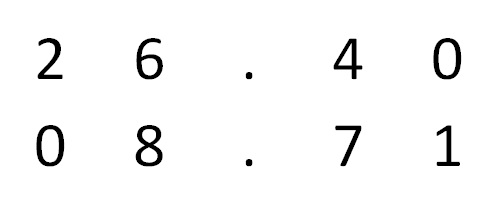In this lesson, we will learn about adding decimals. You already know how to add multi-digit whole numbers. The procedures for adding decimals are basically the same as they are for whole numbers but there are a few important differences that you need to know about. And, that's what we are going to learn about in this lesson.
Are you ready?
Let's start with an easy multi-digit addition.
When adding multi-digit whole numbers, the key was to stack the numbers up so that the ones place digits line up in a column which ensured that all of the other number places lined up in columns too. Then, you just add up the digits in each column, starting with the one's place and working to the left.
Well, adding multi-digit decimal numbers works the same way. The main difference is that instead of lining up the ones place digit when we stack the numbers, we line up the decimal points instead.
The decimal is our reference mark that always goes between the one's place and the tenths place.
For example, in 26.4, 6 is at one's place and 4 is at tenths' place.
Try this! In 8.71, which number is at one's place and tenths' place.
Answer: 8 is at one's place and 7 is at tenths' place.
So, lining up the decimal points is the same thing as lining up the one's place. It makes sure all the number places line up in columns.

Now, you've probably noticed that decimal numbers can have different numbers of decimal digits. For example, 15.2 has only one decimal digit, but 6.47 has two decimal digits. And, that means is when you line up the decimal points of the two decimal numbers, they might not form a nice column on the right edge. Some of the digits might be missing.

But that's no problem. Remember, if there's no digit in a particular number place, you can just put a zero there to help you keep track of things.

Now that these numbers are lined up by their decimal points, we can add them column-by-column. But, instead of starting with the ones place like we always did with whole numbers, we start with whatever number place column is the furthest to the right. In this case, that's the hundredths place, so we'll start here. So, we add the digits in each column, carrying as needed, and we get 3 5 1 1
We aren't done yet. There's one last really important step. Remember, we are doing decimal addition, so we can't just forget about that decimal point. We need to bring a copy of it straight down into our answer line so we keep the same reference point for our number places.
Now, we can see the right answer is 35.11
That's not so hard to do. Isn't it?
Let's practice some decimal addition.